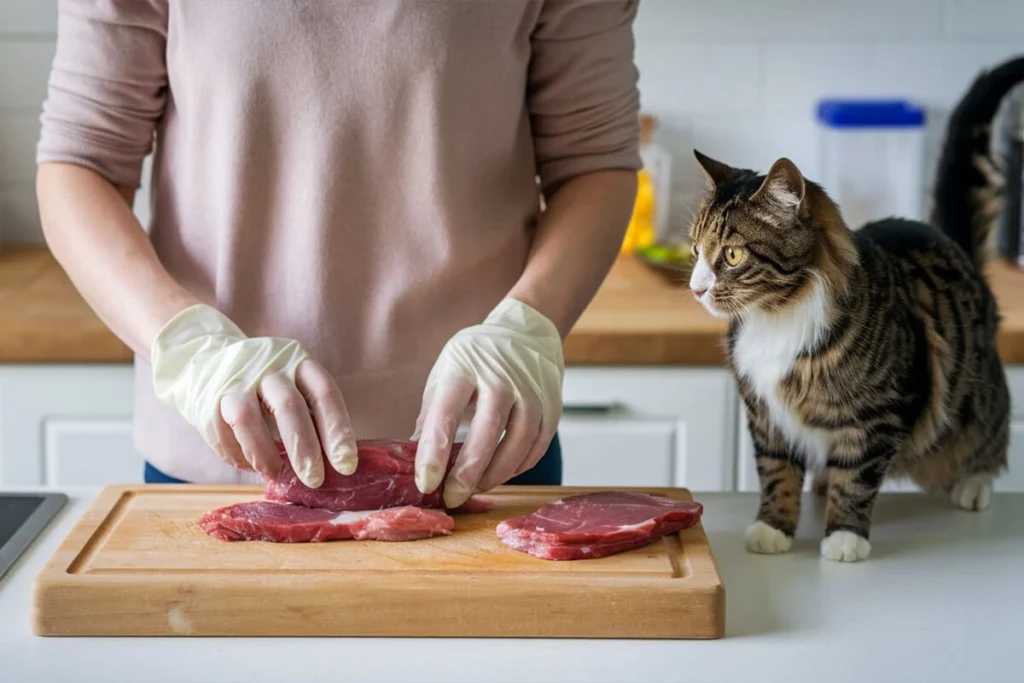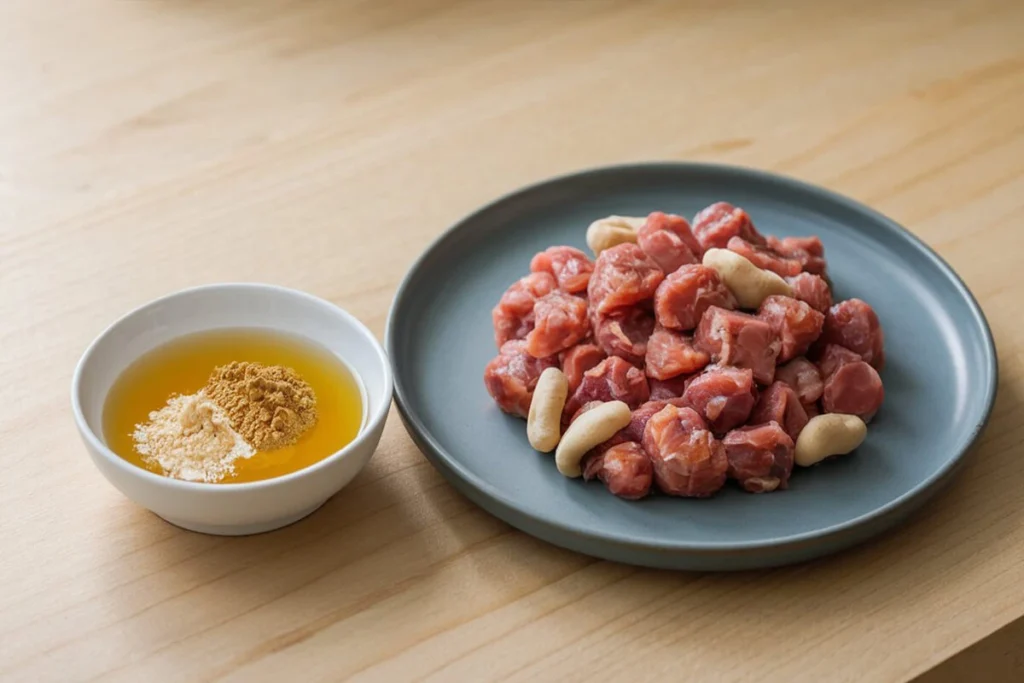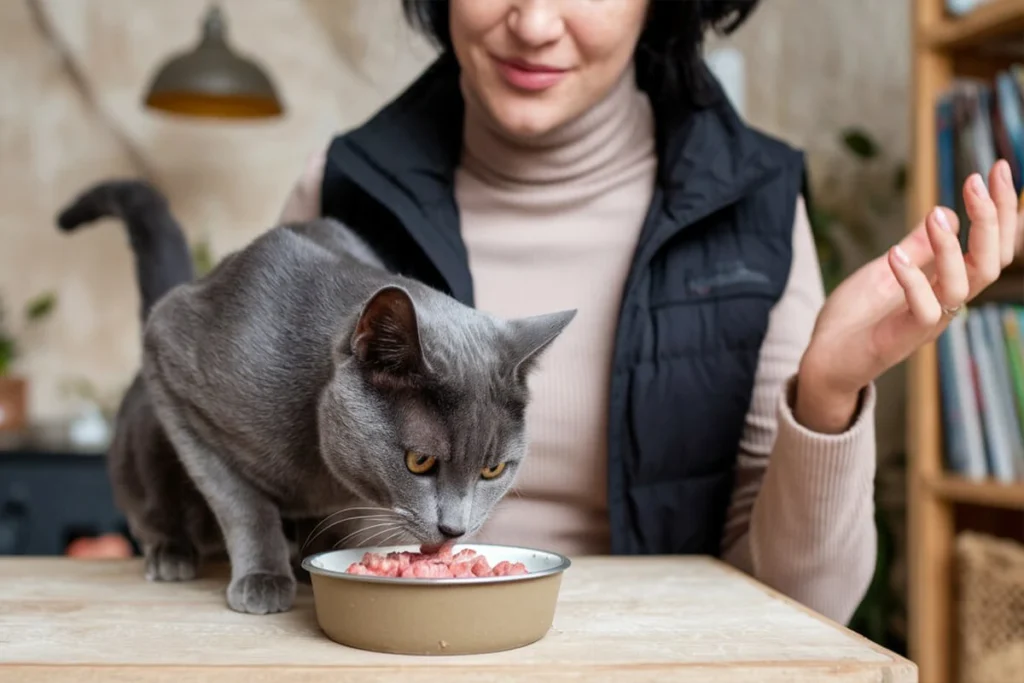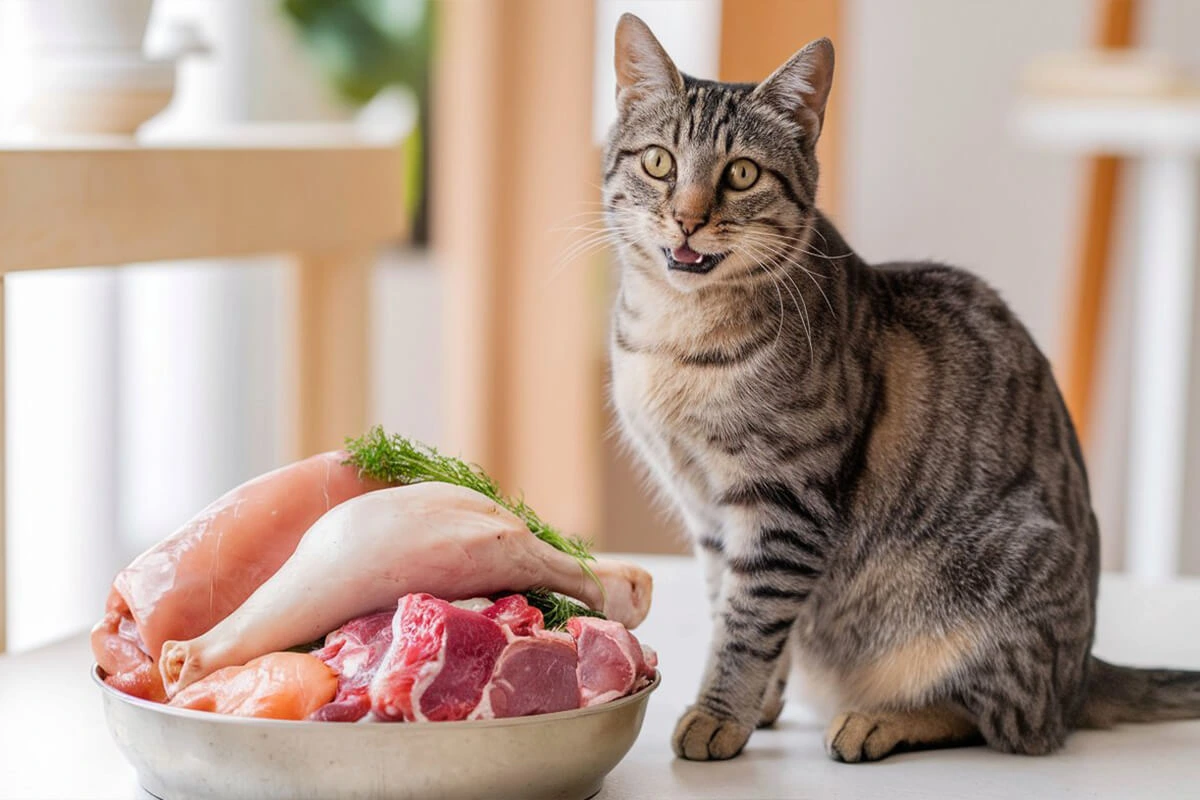Feeding your cat a raw cat food diet has become an increasingly popular choice among pet owners who want to provide a more natural and species-appropriate diet. Unlike commercial kibble and canned food, which often contain fillers, preservatives, and artificial ingredients, raw feeding focuses on whole, fresh ingredients that closely resemble what cats would eat in the wild. This approach supports better digestion, improved coat health, and increased energy levels, making it a great option for feline nutrition.
However, feeding a natural cat diet requires careful planning to ensure that your cat gets all the essential nutrients. A well-balanced raw diet includes muscle meat, organ meats, and raw bones, along with necessary supplements to prevent nutritional deficiencies. While raw feeding offers many benefits, it also comes with challenges such as proper food handling, ingredient selection, and a smooth transition process.
In this guide, we’ll cover 10 essential tips to help you create a safe, nutritious, and well-balanced raw diet for your cat. Whether you’re new to raw feeding for cats or looking to refine your approach, these tips will ensure your feline friend stays healthy and happy. Let’s dive in!
Understanding the Basics of a Raw Cat Food Diet
What is Raw Feeding for Cats?
Raw feeding for cats is a diet based on unprocessed, natural ingredients that mimic what felines eat in the wild. Instead of commercial kibble or canned food, this diet consists of fresh raw meat, organs, and bones, providing essential nutrients without artificial additives. Many cat owners choose raw feeding because it aligns with a cat’s biological needs as an obligate carnivore. Unlike omnivores, cats rely on animal-based proteins and fats for optimal health, making raw food an excellent choice for maintaining strong muscles, healthy skin, and overall vitality.
Key Components of a Raw Cat Food Diet
To ensure a balanced raw diet, cat owners must include the right combination of ingredients. The three main components of a raw feeding plan include:
- Muscle Meat: The primary source of protein, essential for maintaining a cat’s strength and energy levels. Chicken, turkey, rabbit, and beef are popular choices.
- Organ Meats: Rich in vital nutrients, organs like liver, kidney, and heart provide essential vitamins and minerals. Liver, in particular, is a powerhouse of vitamin A, while the heart is an excellent source of taurine.
- Raw Bones: A natural source of calcium and phosphorus, raw bones help support strong teeth and bones. Cats can safely consume small, raw, meaty bones like chicken wings and necks, but owners must avoid cooked bones, which can splinter.
The Importance of Taurine in a Feline Raw Diet
Taurine is an essential amino acid for cats, meaning their bodies cannot produce it on their own, and they must obtain it from their diet. A taurine deficiency can lead to severe health issues, including heart disease (dilated cardiomyopathy), vision problems, and weakened immunity. Raw diets naturally provide taurine, particularly from heart muscle meat (such as chicken or beef heart), making it a critical component of any raw feeding plan. While a properly balanced raw diet typically meets a cat’s taurine needs, some pet owners choose to add taurine supplements to ensure optimal levels.
By understanding these key elements, cat owners can create a feline raw diet that supports long-term health and well-being.
Choosing the Right Ingredients for a Balanced Diet
Best Raw Food for Cats
Choosing the best raw food for cats starts with selecting high-quality, fresh ingredients that meet their nutritional needs. Since cats are obligate carnivores, their diet should consist primarily of animal-based proteins and fats. The most common and well-tolerated protein sources include:
- Chicken – A widely available and affordable option, rich in protein and essential amino acids.
- Turkey – A leaner alternative to chicken, providing variety in a cat’s diet.
- Rabbit – A novel protein that closely resembles what wild cats consume. It’s easily digestible and a great option for cats with food sensitivities.
- Beef – A nutrient-dense protein source that includes iron, B vitamins, and taurine, especially in heart meat.
- Fish (in moderation) – Small amounts of raw fish like sardines can provide omega-3 fatty acids, but excessive feeding can lead to thiamine deficiency.

When selecting raw food for your cat, always opt for human-grade meats from reputable sources. Avoid processed meats, seasoned or cured products, and anything that contains added preservatives.
Importance of Variety in a Raw Diet
Feeding a variety of proteins and organ meats is crucial for a balanced raw diet. Different protein sources offer varying nutrient profiles, ensuring that your cat receives all the essential vitamins, minerals, and amino acids. Relying too heavily on a single type of meat can lead to deficiencies or imbalances.
Here’s why variety matters:
- Balanced Nutrition: Different meats contain varying levels of taurine, omega fatty acids, and essential vitamins.
- Prevents Food Sensitivities: Exposing your cat to multiple proteins can reduce the risk of developing allergies.
- Encourages a Healthy Appetite: Some cats get bored of eating the same food daily. Rotating proteins keeps meals interesting.
A well-rounded raw feeding plan should include at least three to four different protein sources over time, along with a mix of organ meats and raw bones.
DIY Raw Cat Food vs. Store-Bought Options
Cat owners can choose between DIY raw cat food and store-bought raw meals, each with its own advantages and drawbacks.
- DIY Raw Cat Food:
- Gives complete control over ingredients and quality.
- Can be more cost-effective in the long run.
- Requires proper knowledge of feline nutrition to ensure a balanced diet.
- Store-Bought Raw Options:
- Convenient and pre-formulated to meet nutritional standards (e.g., AAFCO guidelines).
- Available in frozen or freeze-dried raw food forms.
- Often more expensive but saves time on meal prep.
Whichever option you choose, ensuring a balanced raw diet is essential. If making raw food at home, consulting a veterinary nutritionist can help ensure your cat gets the right nutrients.
Food Safety & Handling Tips for Raw Feeding
Proper Storage and Handling of Raw Meat for Cats
Handling raw meat for cats requires careful storage and preparation to maintain freshness and prevent contamination. Since raw food lacks preservatives found in commercial cat food, improper storage can lead to bacterial growth, spoilage, and potential health risks.

Follow these key storage guidelines:
- Keep raw meat frozen until needed – Store raw cat food in airtight containers or vacuum-sealed bags and freeze at 0°F (-18°C) or below to preserve nutrients and prevent bacteria from multiplying.
- Label and date all raw food – This helps track freshness and ensures older batches are used first.
- Refrigerate after thawing – Once thawed, raw food should be kept in the refrigerator at 40°F (4°C) or below and used within 2–3 days.
- Avoid cross-contamination – Store raw cat food separately from human food, ideally in a designated container or section of the fridge.
By following these storage tips, you can keep your cat’s raw meals fresh, safe, and nutritionally intact.
Preventing Bacterial Contamination and Ensuring Food Safety
Since raw meat can carry bacteria like Salmonella and E. coli, proper food safety measures are essential to protect both your cat and household members. While cats have strong stomach acids and a short digestive tract that help them handle bacteria, humans are more vulnerable to cross-contamination.
Here’s how to ensure food safety:
- Wash hands and surfaces thoroughly – Always clean your hands, utensils, and food prep areas with hot soapy water before and after handling raw food.
- Use separate cutting boards and bowls – Keep raw cat food preparation tools separate from those used for human meals.
- Discard uneaten food properly – Never leave raw food sitting out for more than 30 minutes. If your cat doesn’t finish its meal, discard it immediately to prevent bacterial growth.
- Regularly sanitize food bowls – Wash cat bowls with warm, soapy water after every meal to prevent residue buildup and bacteria growth.
By following these hygiene practices, you can minimize bacterial risks while safely feeding a natural cat diet.
Safe Thawing and Portioning Techniques
Proper thawing and portioning help maintain the nutritional quality of raw feeding for cats while preventing spoilage and waste.
Best thawing practices include:
- Refrigerator thawing (best method): Transfer frozen portions to the fridge 12–24 hours before feeding. This slow thawing method keeps food at a safe temperature and preserves nutrients.
- Cold water thawing (faster method): If you need to thaw food quickly, place the sealed raw portion in a bowl of cold water for 30–60 minutes. Never use warm or hot water, as it can encourage bacterial growth.
- Avoid microwave thawing: Microwaving can cause uneven heating, destroying essential nutrients and cooking parts of the meat, which defeats the purpose of a raw diet.
For portioning:
- Pre-portion raw meals before freezing – Divide food into daily servings to make mealtime easy and convenient.
- Use airtight containers – Store individual portions in BPA-free plastic or glass containers to maintain freshness.
- Feed appropriate amounts – Portion sizes depend on your cat’s weight, age, and activity level. On average, cats need 2–4% of their body weight in raw food per day.
By using proper thawing and portioning techniques, you can ensure your cat’s raw food stays fresh, safe, and nutritionally balanced.
Supplementing a Raw Diet for Optimal Cat Nutrition
Essential Supplements for Raw Feeding
A properly formulated raw cat food diet should closely mimic what cats would consume in the wild. While fresh muscle meat, organs, and bones provide many essential nutrients, some key vitamins and minerals may still be missing. Adding the right supplements for raw feeding helps prevent deficiencies and ensures a balanced diet.

Here are the most important supplements to consider:
- Taurine is an important amino acid that helps with heart health, eyesight, and feeling good overall.. Raw-fed cats typically get taurine from heart meat, but supplementation may be needed, especially if feeding lean meats.
- Omega-3 Fatty Acids: Found in fish oil and krill oil, omega-3s support skin health, reduce inflammation, and promote a shiny coat. Sardine oil is a great cat-friendly source.
- Calcium: If not feeding raw bones, calcium must be supplemented using eggshell powder or bone meal to maintain proper bone and dental health.
- Vitamin E: Essential for a cat’s immune system and skin health, especially if feeding fish-based proteins, which can deplete vitamin E levels over time.
- B-complex Vitamins: Support metabolism, nervous system function, and energy levels. Liver provides many B vitamins, but some cats may benefit from additional supplementation.
While DIY raw cat food allows for flexibility, it’s crucial to ensure all necessary nutrients are included. Deficiencies can lead to severe health problems, so supplementing appropriately is essential for a well-rounded natural cat diet.
The Role of Bone Broth in Cat Nutrition
Bone broth is a highly nutritious and hydrating addition to a feline raw diet. Made by simmering animal bones and connective tissues, it extracts essential nutrients that benefit cats in multiple ways.
Key benefits of bone broth:
- Supports Joint Health: Rich in collagen and glucosamine, bone broth helps maintain joint mobility and reduce inflammation.
- Aids Digestion: The gelatin in bone broth soothes the digestive tract, making it especially helpful for cats transitioning to raw food.
- Boosts Hydration: Many cats don’t drink enough water. Bone broth provides an easy way to increase moisture intake.
- Strengthens the Immune System: Packed with amino acids and minerals, it helps support overall immune function.
To prepare bone broth, simmer raw bones (such as chicken or turkey) in water for 12–24 hours. Avoid adding onions, garlic, or excessive salt, as these are toxic to cats. Serve it as a topper over raw meals or offer small amounts as a nutritious treat.
When to Consult a Veterinary Nutritionist for a Balanced Raw Diet
While many cat owners successfully prepare DIY raw cat food, consulting a veterinary nutritionist can provide expert guidance, especially for beginners or those feeding cats with special dietary needs.
Consider seeking professional advice if:
- Your cat has health conditions – Cats with kidney disease, digestive disorders, or food allergies may require custom raw feeding plans.
- You’re unsure about nutritional balance – A nutritionist can help formulate a balanced raw diet that meets AAFCO guidelines and ensures your cat gets all essential nutrients.
- You’re transitioning from commercial food – Getting expert advice can make the switch smoother and minimize digestive issues.
- You prefer home-prepared raw meals but need confirmation – A nutritionist can review your feeding plan and recommend necessary adjustments.
Working with a professional ensures that your cat’s raw diet is nutritionally complete and safe, preventing deficiencies and long-term health issues. If unsure, always prioritize expert guidance for the best results in raw feeding for cats.
Transitioning Your Cat to a Raw Food Diet
Gradual Transition Steps to Avoid Digestive Upset
Switching your cat to raw cat food should be done gradually to allow their digestive system to adjust. Cats that have been eating kibble or canned food for a long time may need extra time to transition smoothly. A sudden change can cause stomach upset, diarrhea, or refusal to eat.

Follow these steps for a successful transition:
- Start with Small Portions – Begin by mixing a small amount of raw food (10-20%) with your cat’s current diet. Slowly increase the raw portion while decreasing commercial food over 7-14 days.
- Introduce One Protein at a Time – Start with a mild protein like chicken or turkey before gradually introducing other meats like rabbit or beef. This helps identify any potential food sensitivities.
- Monitor Stool Consistency – Loose stools or vomiting may indicate that the transition is too fast. If this happens, slow down the process and offer bone broth to support digestion.
- Encourage Hydration – Cats eating kibble may not be used to high-moisture foods. Encourage water intake by offering bone broth or placing extra water bowls around the house.
- Stay Consistent and Patient – Some cats take longer to accept raw food. Offering freeze-dried raw food as an intermediate step can help picky eaters adjust to the taste and texture.
A slow and steady approach will reduce stress and ensure your cat adapts comfortably to a natural cat diet.
Monitoring Your Cat’s Health and Energy Levels During the Switch
Once your cat starts eating raw food, closely observe their behavior, digestion, and overall health. A well-balanced feline raw diet should lead to noticeable improvements in energy, coat quality, and digestion.
What to monitor:
- Energy Levels – A properly fed raw-fed cat will become more active and alert. If your cat seems lethargic, it may indicate an imbalance in their diet.
- Coat and Skin Condition – A shinier, softer coat with less shedding is a sign that the diet is working well. Dry skin or excessive itching may require adjustments in omega-3 intake.
- Stool Quality – Raw-fed cats typically have smaller, firmer, and less smelly stools due to better nutrient absorption. Loose stools may indicate too much organ meat, while hard stools may require more moisture or fiber.
- Weight Maintenance – Weigh your cat regularly to ensure they are not losing or gaining too much weight. Adjust portion sizes accordingly, feeding 2-4% of their body weight per day.
Regular monitoring helps detect any dietary issues early, ensuring a smooth and healthy transition to raw feeding for cats.
Common Challenges and How to Troubleshoot Them
Transitioning to DIY raw cat food can come with some obstacles, but most issues have simple solutions.
1. My Cat Refuses to Eat Raw Food
- Some cats are hesitant about new textures and flavors. Try lightly warming the raw food to enhance the scent.
- Mix raw food with a bit of their current diet, gradually increasing the raw portion.
- Offer freeze-dried raw food first, then transition to fresh raw meals.
2. My Cat is Experiencing Digestive Upset (Diarrhea or Vomiting)
- Slow down the transition process to allow their gut to adjust.
- Make sure you’re feeding the correct muscle meat, organs, and bones ratio (80:10:10).
- Add probiotics or bone broth to aid digestion.
3. My Cat is Losing Weight Too Quickly
- Ensure you’re feeding enough food based on their ideal body weight (typically 2-4% of body weight per day).
- Increase meal portions slightly and monitor weight changes weekly.
4. My Cat is Constipated or Having Hard Stools
- If stools are too dry or hard, increase hydration by offering bone broth or adding a small amount of pumpkin for fiber.
- Reduce bone content slightly, as too much calcium can cause constipation.
By addressing these common challenges, you can ensure a smooth transition to a balanced raw diet that keeps your cat healthy and happy.
Conclusion
Switching to raw cat food is one of the best ways to support your feline’s overall health, energy levels, and longevity. A properly balanced feline raw diet provides the essential nutrients cats need to thrive, mimicking what they would naturally eat in the wild. Unlike commercial kibble filled with fillers and artificial additives, raw feeding for cats focuses on high-quality, unprocessed meats, organs, and bones that support strong muscles, a healthy immune system, and a shiny coat.
Ensuring a balanced raw diet requires careful planning. Incorporating a variety of proteins, adding essential supplements like taurine and omega-3s, and following proper storage and handling techniques all contribute to a safe and nutritionally complete meal plan. Paying attention to portioning, gradual transitioning, and food safety measures will help your cat adjust smoothly while preventing digestive issues.
Whether you choose DIY raw cat food or opt for store-bought raw options, always prioritize quality ingredients and proper nutrient balance. Consulting a veterinary nutritionist can help fine-tune your cat’s diet and ensure they receive all the essential vitamins and minerals. Regularly monitoring your cat’s energy levels, weight, stool quality, and coat condition will help you determine if any dietary adjustments are needed.
By committing to raw feeding for cats, you’re making an investment in your cat’s long-term health and well-being. With proper planning and a focus on high-quality nutrition, your feline companion can enjoy a life full of vitality, free from the common health issues associated with processed pet food.
Discover the Top Homemade Cat Food & the best Recipes For a Healthy & Happy Feline!
What’s the best Cat Food Every Owner Should Know About?
Discover the Top Dry Cat Food For a Healthy & Happy Feline.
Get Some Good Stuff for your Cat From Pet MD Official
